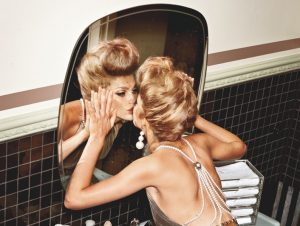HISTORIC, side-long, implicating eyes ;
A smile of velvet’s lustre on the cheek ;
Calm lips the smile leads upward ; hand that lies
Glowing and soft, the patience in its rest
Of cruelty that waits and doth not seek
For prey ; a dusky forehead and a breast
Where twilight touches ripeness amorously :
Behind her, crystal rocks, a sea and skies
Of evanescent blue on cloud and creek ;
Landscape that shines suppressive of its zest
For those vicissitudes by which men die.
“La Gioconda” is a poem written by Michael Field (a pseudonym for Katharine Bradley and Edith Cooper) that was published in the volume “Sight and Song”. This poem is about Leonardo da Vinci’s painting, Mona Lisa. The annotation over the final word “die” reads, “Pater likens Mona Lisa to a vampire: ‘She is older than the rocks among which she sits; like the vampire, she has been dead many times, and learned the secrets of the grave’”. This mention of Mona Lisa as a vampire made me think back to Dracula, to compare Mona Lisa to the female vampires Jonathan Harker encounters on pages 44-47. One connection that Mona Lisa has to these women is that Bram Stoker puts great emphasis on the lips and mouth of these vampires, while the lips, mouth, and smile of the Mona Lisa is one of the most commonly discussed part of the painting. In “La Gioconda”, Michael Field mentiones her smile in the second line: “A smile of velvet’s lustre on the cheek”. He then mentions her lips in the next line stating, “Calm lips the smile leads upward.” In Dracula, Jonathan Harker takes note of the “ruby of [the female vampire’s] voluptuous lips” (45 Stoker) and later mentions that they are “scarlet” (45 Stoker). He is attracted to the lips of the female vampire, declaring “I felt in my heart a wicked, burning desire that they would kiss me with those red lips” (45 Stoker). In the short scene where these women try to suck Jonathan’s blood, their lips get mentioned eight times. As stated in one of my previous posts “Fear of the New Woman”, these female vampires are incredibly sexualized and can be seen as examples of the type of fear that existed during the fin de siècle (for example- Lucy feeding on the baby instead of feeding the baby is representative of the fear of the abandonment of motherhood). The last line of “La Gioconda”: “Landscape that shines suppressive of its zest/ For those vicissitudes by which men die” can also be related to the idea of the New Woman. The OED definition of vicissitude mentioned in the annotation is: “The fact of change or mutation taking place in a particular thing or within a certain sphere.” The change “by which men die” could be the changing role of the woman as they turn away from motherhood and marriage, start gaining ownership over their own property/money, and gain new opportunities for jobs/education. Perhaps the Mona Lisa can be seen as an example of the New Woman.


